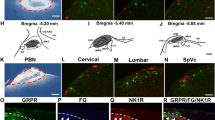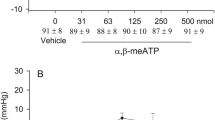Abstract
THE undecapeptide substance P (SP) may act as a transmitter released from the terminals of primary sensory nerves in the spinal cord1–2. SP has been shown to be highly concentrated in the terminals of small diameter fibres in the substantia gelatinosa of the dorsal horn in mammalian spinal cord, and these terminals disappear after dorsal root section3–6. Sensory nuclei of some of the cranial nerves, such as the spinal trigeminal nucleus, also contain a high density of SP nerve terminals6–7. SP is released by a calcium-dependent mechanism from the isolated rat spinal cord during electrical stimulation of the dorsal roots8. The peptide is also a powerful excitant of neurones in the spinal cord2, and seems to excite selectively those cells in dorsal horn that respond to noxious stimuli9–10. SP may, therefore, represent the excitatory transmitter, or one of the transmitters, released from primary fibres involved in the transmission of pain. We have examined the stimulus-evoked release of SP from rat spinal trigeminal nucleus slices in vitro to explore the factors which may control its release from primary sensory terminals. We report here that opiate analgesics are able to suppress the stimulus-evoked release of SP. These findings may represent a mechanism for the direct spinal analgesic actions of opiates.
This is a preview of subscription content, access via your institution
Access options
Subscribe to this journal
Receive 51 print issues and online access
$199.00 per year
only $3.90 per issue
Buy this article
- Purchase on Springer Link
- Instant access to full article PDF
Prices may be subject to local taxes which are calculated during checkout
Similar content being viewed by others
References
Lembeck, F. N. S. Archiv. Pharmac. 219, 197–213 (1953).
Otsuka, M. & Konishi, S. Cold Spring Harb. Symp. quant. Biol. 40, 135–143 (1975).
Takahashi, T. & Otsuka, M. Brain Res. 87, 1–11 (1975).
Kanazawa, I & Jessell, T. M. Brain Res. 117, 362–367 (1976).
Hökfelt, T., Kellerth, J. O., Nillson, G. & Pernow, B. Brain Res. 100, 235–252 (1975).
Cuello, A. C. & Kanazawa, I. J. comp. Neurol. (in the press).
Hökfelt, T., Kellerth, J. O., Nillson, G. & Pernow, B. Science 190, 889–890 (1975).
Otsuka, M. & Konishi, S. Nature 264, 83–84 (1976).
Henry, J. L. Brain Res. 114, 431–451 (1976).
Miletic, V. & Randic, M. Brain Res. 128, 164–169 (1977).
Atweh, S. F. & Kuhar, M. J. Brain Res. 124, 53–67 (1977).
Snyder, S. H., Uhl, G. R. & Kuhar, M. J. Biol. Council Symp. Centrally Acting Peptides (ed. Hughes, J.) (Macmillan, London, in the press).
Jessell, T. M., Iversen, L. L. & Kanazawa, I. Nature 264, 81–83 (1976).
Jessell, T. M. Br. J. Pharmac. Chemother. 59, 486P (1977).
Hughes, J. et al. Nature 258, 577–579 (1975).
Simantov, R. & Snyder, S. H. J. Neurochem. 28, 13–20 (1977).
Pert, C. B., Pert, A., Chang, J.–F., Fong, B. T. W. Science 194, 330–332 (1976).
Bradbury, A. F. et al. Nature 260, 793–795 (1976).
Loh, H. H. et al. Nature 264, 567–568 (1976).
Elde, R., Hökfelt, T., Johnson, S. O., Ljungdahl, A., Nilsson, G. & Jeffcoate, S. L. Biol. Council Symp. Centrally Acting Peptides (ed. Hughes, J.) (Macmillan, London, in the press).
LaMotte, C., Pert, C. B. & Snyder, S. H. Brain Res. 112, 407–412 (1976).
Starke, K. Rev. Physiol. Biochem. Pharmac. 77, 1–124 (1977).
Calvillo, O., Henry, J. L. & Neuman, R. S. Can. J. Physiol. Pharmac. 52, 1207–1211 (1974).
Duggan, A. W., Hall, J. G. & Headley, P. M. Nature 264, 456–458 (1976).
Le Bars, D., Guilbaud, G., Jurna, I. & Besson, J. M. Brain Res. 115, 518–524 (1976).
Yaksh, T. L. & Rudy, T. A. Science 192, 1357–1358 (1976).
Melzack, R. & Wall, P. D. Science 150, 971–979 (1965).
Author information
Authors and Affiliations
Rights and permissions
About this article
Cite this article
JESSELL, T., IVERSEN, L. Opiate analgesics inhibit substance P release from rat trigeminal nucleus. Nature 268, 549–551 (1977). https://doi.org/10.1038/268549a0
Received:
Accepted:
Issue Date:
DOI: https://doi.org/10.1038/268549a0
This article is cited by
Comments
By submitting a comment you agree to abide by our Terms and Community Guidelines. If you find something abusive or that does not comply with our terms or guidelines please flag it as inappropriate.



